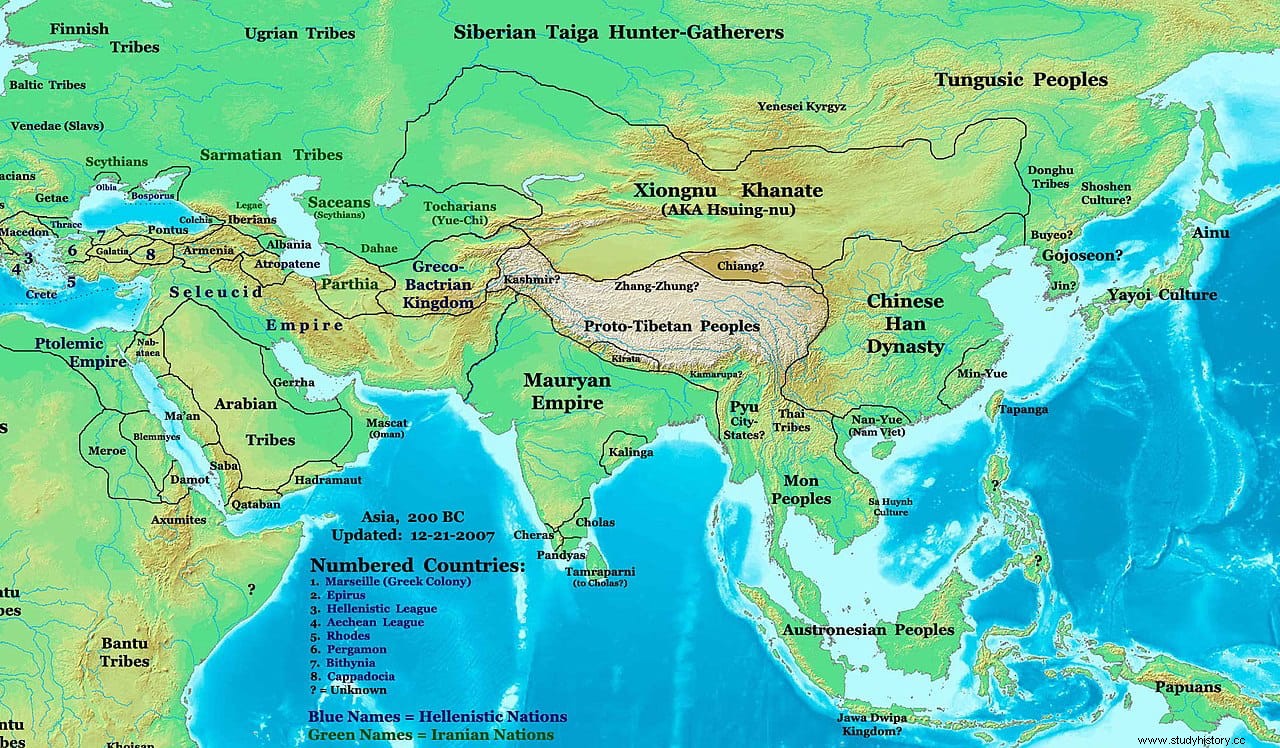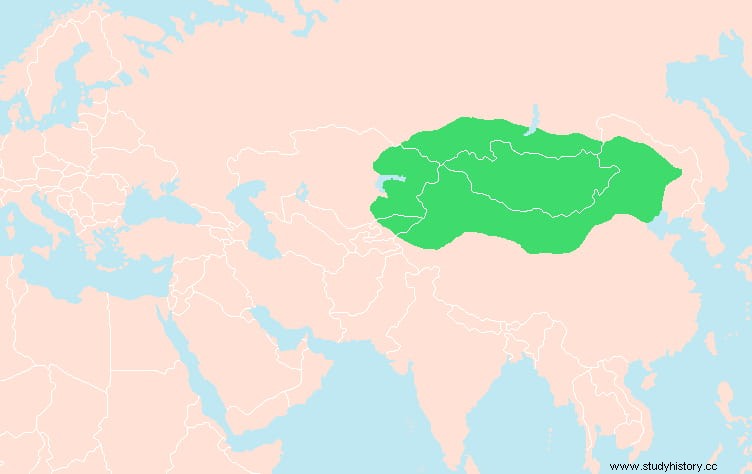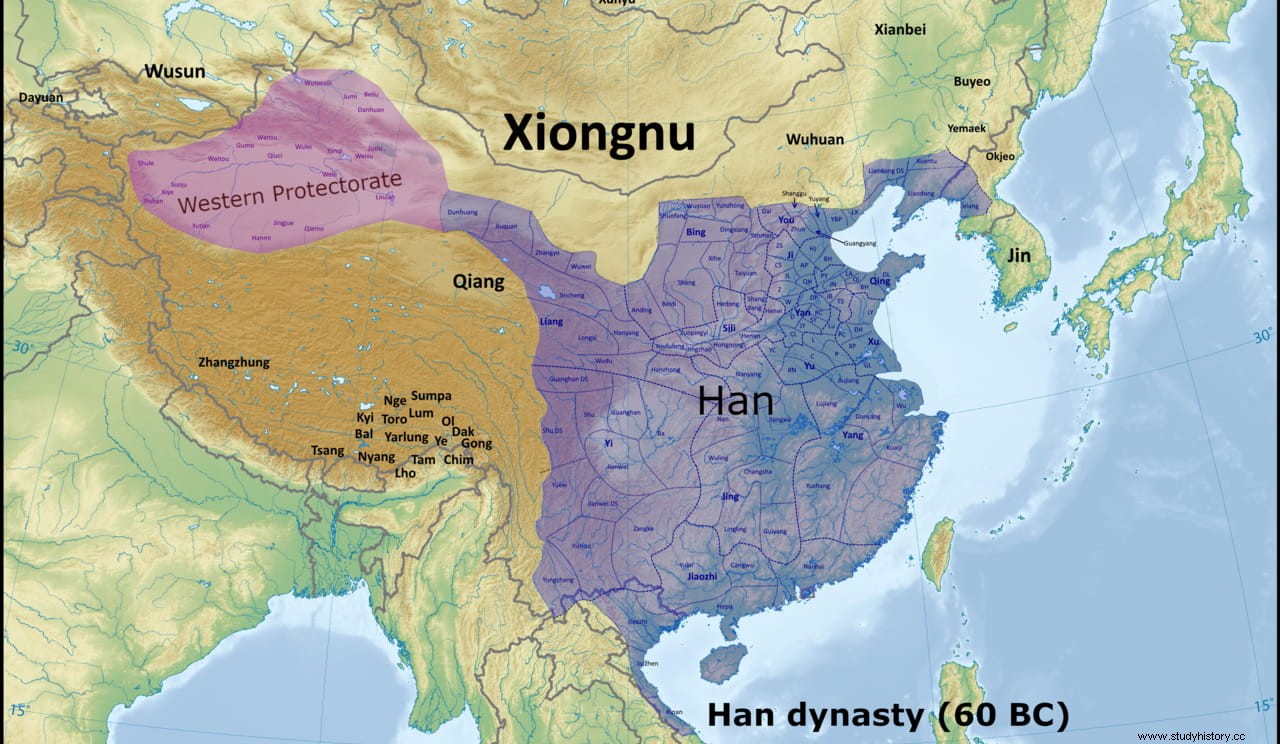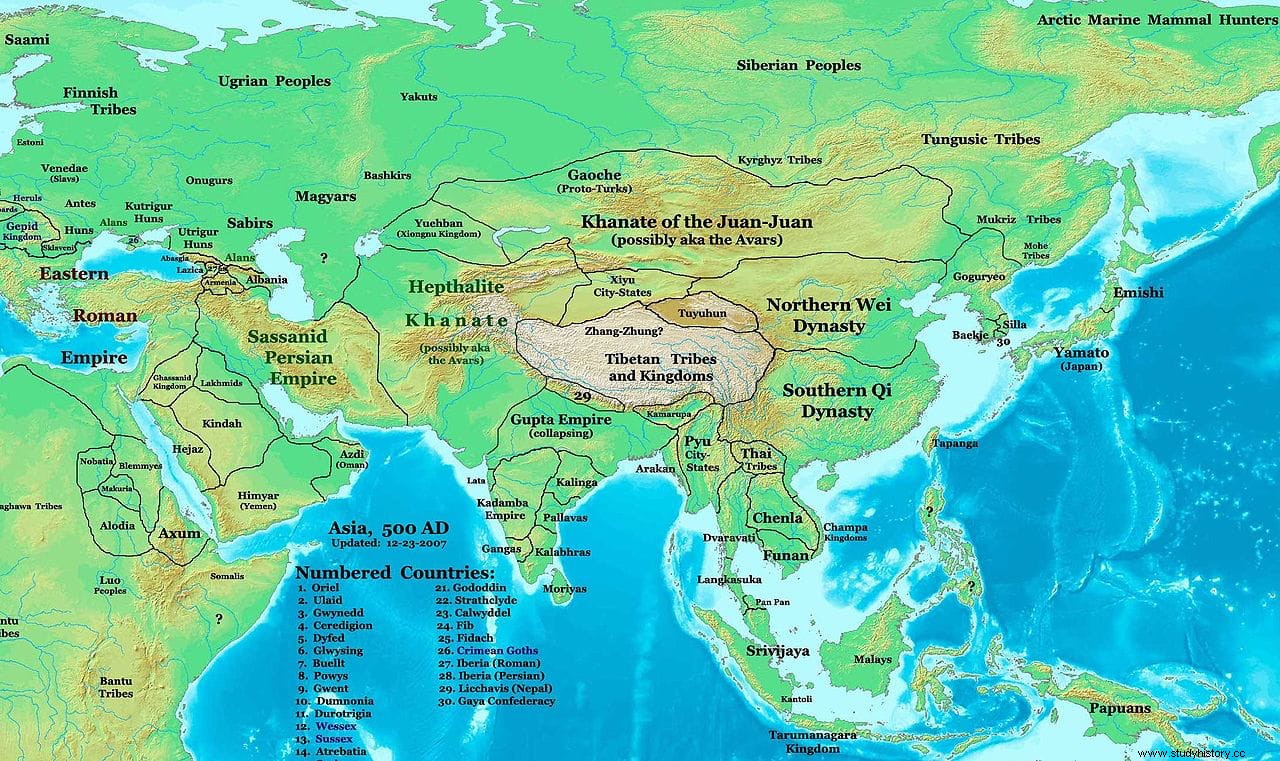The expression "mosaic of peoples" is frequently used to refer to the numerous and varied ethnic and cultural composition that characterized Central Asia in ancient times, to the point that even when we refer to one in particular, it was often a confederation of several of them. This is the case of the Xiongnu, a group of nomadic tribes that became the dominant empire in the steppes during the second century BC. and whose evolution could have originated -there is no historiographical agreement on the matter- some of the groups that were later better known, such as the Mongols, Turks and even Huns.
The Chinese considered the Xiongnu one of the so-called Wu Hu, that is, the Five Barbarians (xiongnu means fierce slave ), an exonym used to refer to non-Chinese peoples along with the Xianbei, Jie, Di, and Qiang. The former and the Xiongnu came from the northern steppes but while the Xianbei have been identified as Mongols, the Xiongnu and remain a mystery, even though they came to occupy northern regions of the country. There are documentary references to them from at least the Han dynasty (for example, they are reviewed by Sima Qian in his Records of the Grand Historian ), underlining this distinctive character with respect to the sedentary culture.
However, the Xiongnu laid the foundations for their heyday before the Han dynasty began. Three years earlier, specifically, in 209 BC, when the second Chanyu was formed. (title of supreme agent). Its owner, Modun, submitted all the eastern steppe peoples, bringing them together in a great confederation and simply executing whoever opposed it. The goal is supposed to be to muster enough strength to deal with the danger posed by the Qin dynasty's unification of China, which had led to the expulsion of the Xiongnu from the Yellow River grazing areas six years earlier. 
In any case, Modun understood that he had to learn from his rivals and his new empire was impregnated with many of their characteristics, so that the Xiongnu copied from the Chinese agricultural techniques, the use of slaves, silk clothes and the architectural tradition. Thanks to this, that confused group prospered and gathered power to begin a process of military expansion, first conquering the southern regions of Siberia, and then continuing with the Donghu of Mongolia and Manchuria, the Yuezhi of Gansu, etc.
For this, they had an efficient hierarchy of command, which had its peak in the aforementioned chanyu , followed by the two kings tuqi (actually princes, among whom was the heir apparent, Tuqi of the West) and continued with a series of civil servant strata:the gulli (general), seconded by the dunghu (commanders) and the gudu (governors), plus other progressively lower ranks. In short, an organization of a military nature, a true reflection of the nomadic condition of that people.
In 200 B.C., the long-awaited moment arrived to confront the Han. Their victorious ambush at the Battle of Baideng against a counterattack led by Emperor Gaozou (also known by his original name, Liu Bang) nearly brought down Han. this one, who only got rid when he managed to convince Modun that, even if he won, he could not retain what he had conquered for a long time. The Xiongnu chieftain also understood this and allowed the encircled emperor to escape, changing his strategy:henceforth, a policy of matrimonial alliances would be customary and he himself would marry Lu Zhi, the emperor's widow.

But that did not imply that Modun gave up his campaigns, that he continued against the yuezhi and the wusun, turning them into vassals. When he died in 174 BC, his empire stretched from the Liao River in the east to the Pamir Mountains in the west and from around Lake Baikal in the north to Lower Mongolia in the south. He succeeded his son Jizhou, whom he had had with the aforementioned widow of Guazou and who received the title of Laoshang Chanyu. With him, the marriage policy was established (not only in the imperial sphere but also in lower hierarchies) and a common market with the Chinese but, at the same time, he betrayed the good relations by penetrating more into China.
He's scion Junchen was the next chunyen on the list starting in 161 BC. The tone was the same:a tense general peace with occasional breaches of it that led to episodes of war. The situation had to explode sooner or later and that happened in 129 BC, when a Chinese army defeated the Xiongnu, starting a period of military triumphs that put the successive chanyu in trouble. and that at the end of the second century B.C. It became more dramatic with the victory of the Han against the Kingdom of Dayuan in the War of the Heavenly Horses, which provided them with a large number of equids with which to swell their troops and balance the superiority in that aspect that they had had until then. the Xiongnu.
As is often the case, the defeats destabilized the Xiongnu confederacy, which began to fall apart. Between the years 60 and 53 B.C. was involved in a civil war, aggravated by the particular form of succession:it was considered that the important thing was that an adult be in charge, so the position of chanyu It did not pass from father to son if he was not old enough for it, but from brother to brother. As you can imagine, this gave rise to numerous dynastic conflicts that the Chinese took advantage of to turn the Xiongnu into a mere tributary state, although it retained its independence and the border between the two was still the Great Wall.

That changed slightly in 48 BC, when the rivalry between the Huhanye and Zhizhi brothers over being chanyu led the former to render vassalage to the emperor with the eight western tribes he controlled; this left the Xiongnu empire divided into two parts, one subject to China and the other, the northern, independent, known as Northern Xiongnu. The latter, under the rule of Punu, tried to annex the south but the Xianbei first and the Chinese later ended up putting an end to it in the middle of the 2nd century AD. In fact, most of its inhabitants went to live in China.
The south did not enjoy peace either due to the threat of Punu but, above all, to a succession of natural disasters and its submission to China, which also sent natives of its country to colonize it. This caused social clashes between settlers and nomads that led to open rebellion in 94 AD. It did not triumph but it could not be completely repressed either and things became entrenched until the end of the 2nd century AD, when the Han also suffered internal insurrections in China. The chanyu Yufuluo, involved once again in a succession conflict, established himself with his people in Pingyang (present-day Linfen, in Shanxi); Upon his death in 195 AD, he handed over the baton to his brother Huchuquan.
To avoid possible expansionist temptations, Cao Cao, the powerful Chancellor of the Han, had Huchuquan arrested and divided the Southern Xiongnu people into five provinces, each headed by a Chinese governor, which also made it easier for him to incorporate his famous cavalry into the army. In a way, it was successful, since the Xiongnu aristocracy sought to increase their prestige by changing their surname to a Chinese one, claiming to be related to the imperial family thanks to that marriage policy started by Modun. But none of this could stop the social struggles between Xiongnus and Chinese.

The following year the south tried to ally itself with the north, for which most of the tribes left China. That would be the trend for decades, hatching in 304 AD. with a great uprising that took advantage of the War of the Eight Princes, one of the civil wars that hit China, disputed during the Jin dynasty (the Han had fallen in 220 AD). It involved the looting of several Chinese cities, including capitals, and in 317 AD, when a new Xiongnu state with its own dynasty had been formed, the collapse of the Western Jin occurred; the Xiongnu seized and executed the last two emperors.
Northern China remained in his hands and Prince Liu Yao changed the name of the founded dynasty, which until then had been called Han Zhao to legitimize itself by connecting with Han China, to Zhao plainly, referring its ancestral origin to Modun . That did not prevent the chaos of continuous warfare from continuing and although Fu Jian managed to unify south and north, it was only temporarily, between 337 and 385 AD. The Xiongnu swan song came fifty-four years later, at the hands of Northern Wei.
Paradoxically, it was a dynasty of the Xiongnu Tuoba clan (hence also called Tuoba Wei), which ruled in the north from 386 AD. and that it unified northern China, leading to the exile of the ruling dynasty in Tiefu, as the southern Xiangnu state was now known. The fled Tiefu founded a new country called Xia and was renamed Helian but was conquered by Northern Wei, who in 439 AD. he also defeated a third remaining branch of the Xiongnu, the Juqu, ending the history of that unique and long-lived empire and ushering in the period of the Northern Dynasties.
